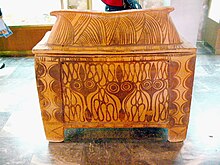


Armeni is the archaeological site of an ancient Minoan cemetery on Crete, roughly eight kilometers south of the modern town of Rethymnon.



Armeni is the archaeological site of an ancient Minoan cemetery on Crete, roughly eight kilometers south of the modern town of Rethymnon.
Armeni has been under excavation since 1969 by Dr. Yiannis Tzedakis. Over 200 chamber tombs and one tholos tomb have been found. All date to the Late Minoan era.
The chambers are approached by entrance passages, or dromos, which start at ground level and descend to the entrance of the tomb. The tombs are not identical, with some having ramps while others have stairs. The walls of the dromos have been cut in such a way that they are closer to each other at the top than they are at the bottom, probably to help bear the weight of the earth above. The entrances were originally covered by a large stone, which is usually still next to the entrance. Several of the larger tombs have a pillar in the center of the chamber. One tomb's walls are lined with stone benches cut directly from the rock.
Artifacts from the chamber tombs include seal stones, jewelry, bronze tools, stone vases, bronze vessels and pottery. Clay larnakes, a type of small coffin, painted with double axes, hunting scenes, and Horns of Consecration were also excavated. These artifacts can be found at the Archaeological Museum of Chania and the Rethymno Museum.
Over 500 skeletons have been excavated, yielding useful information about the diet of the Minoan people in this area. They ate high carbohydrate diets but not much meat.
The site is open to tourists, including entrance into several of the main rock-cut tombs. Automatic lighting has been installed. There is an entrance fee of €3. [1]
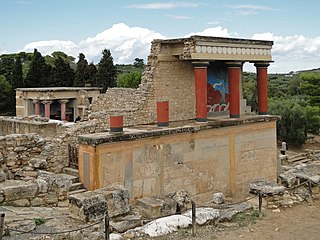
Knossos is a Bronze Age archaeological site in Crete. The site was a major center of the Minoan civilization and is known for its association with the Greek myth of Theseus and the minotaur. It is located on the outskirts of Heraklion, and remains a popular tourist destination.
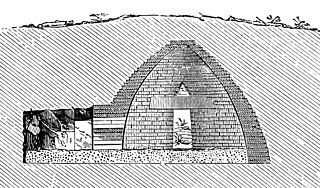
A beehive tomb, also known as a tholos tomb, is a burial structure characterized by its false dome created by corbelling, the superposition of successively smaller rings of mudbricks or, more often, stones. The resulting structure resembles a beehive, hence the traditional English name.
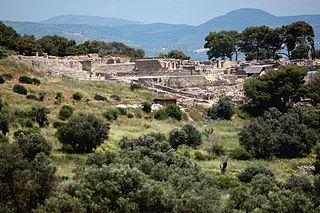
Phaistos ), also transliterated as Phaestos, Festos and Latin Phaestus, is a Bronze Age archaeological site at modern Faistos, a municipality in south central Crete. It is notable for the remains of a Minoan palace and the surrounding town.

Pyrgos is an archaeological site of the Minoan civilization near Myrtos in the municipality of Ierapetra on the south coast of Crete. Pyrgos provides evidence of settlements along the southern Ierapetra Isthmus. This site has had a long history due to its valuable location and geography. It is located close to the Myrtos valley and has a harbor with a nearby mountain range providing its protection. The settlement includes a courtyard, many rooms, a country house and a tomb.


Maleme is a small village and military airport 16 km (9.9 mi) to the west of Chania, in north western Crete, Greece. It is located in Platanias municipality, in Chania regional unit.

The Treasury of Atreus or Tomb of Agamemnon is a large tholos or beehive tomb constructed between 1300 and 1250 BCE in Mycenae, Greece.

Pseira is an islet in the Gulf of Mirabello in northeastern Crete with the archaeological remains of Minoan and Mycenean civilisation.

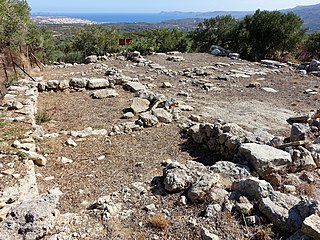
Achladia is the archaeological site of an ancient Minoan villa on eastern Crete.

Mochlos is a modern, populated, and inhabited island in the Gulf of Mirabello in eastern Crete, and the archaeological site of an ancient Minoan settlement. There is evidence that Mochlos was not an island in Minoan times, but was attached to the mainland and acted as an eastern harbor.

Phourni is the archaeological site of an ancient Minoan cemetery in Crete, established in 2400 BC and lasted until 1200 BC. Phourni is Greek for "furnace, oven" and the name of the hill on which the cemetery is located. Phourni is located at 70100 Epano Archanes, Heraklion, Greece—located on a hill in north-central Crete. Phourni can be seen from Mount Juktas. It is a small hill situated northwest of Archanes, between Archanes and Kato Archanes. Phourni is reachable from a signed scenic path that starts at Archanes. It was an important site for Minoan burials. The burials consistently and proactively engaged the community of the Minoans. The largest cemetery in the Archanes area was discovered in 1957 and excavated for 25 years by Yiannis Sakellarakis, beginning in 1965. The 6600 sq m cemetery includes 26 funerary buildings of varying shapes and sizes. The necropolis of Phourni is of primary importance, both for the duration of its use and for the variety of its funerary monuments. All the pottery and much of the skeletal material was collected, unlike many other pre-palatial tombs. The cemetery was founded in the Ancient Minoan IIA, and continued to be used until the end of the Bronze Age. The occupation reached its peak during the Middle Minoan AI, just before the palaces of Knossos and Malia appeared. The proximity of Archanes to the important religious centres of Mount Iuktas probably contributed to the prominence of the site.

Monastiraki is the archaeological site of an ancient Minoan town on the island of Crete. The site is on the plain of Amari, west of the Ida massif, 38 kilometres from Rethymnon.
Tripiti is the archaeological site of an ancient Minoan settlement in southern Crete, Greece, along the coast to the east of the village of Lendas.
Apesokari is the archaeological site of an ancient Minoan cemetery. It is also a modern village with a population of 103 (2011) and is built at 155 m above sea level. It is in the municipality of Gortyna in the south of Heraklion regional unit, Greece.
Odigitria is the archaeological site of an ancient Minoan religious complex including two tholos tombs located near the modern Odigitria Monastery in the Asterousia mountains of southern Crete.

Anemospilia is the archaeological site of an ancient Minoan temple on Crete.

Hagia Photia is an archaeological site of a fortified ancient Minoan building on eastern Crete. Sitia lies five kilometers to the west.

Chamaizi is an ancient archaeological site in eastern Crete with the only known oval-shaped building of the Minoan period. Below this building is evidence of Early Minoan building foundations.
The Griffin Warrior Tomb is a Bronze Age shaft tomb dating to around 1450 BC, near the ancient city of Pylos in Greece. The grave was discovered by a research team sponsored by the University of Cincinnati and led by husband-and-wife archaeologists Jack L. Davis and Sharon Stocker. The tomb site was excavated from May to October 2015.